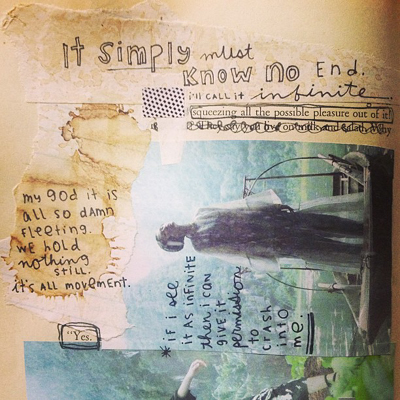 "Crash into me" a cool journal page from The Art Journaler (See Link Below) A Visual Crash Course into the Mind & Soul…
The other day I paid a visit to the Tumblr blog of a new creative friend: Watching Angel. Journeying through her blog, I discovered many wonderful postings: artwork (hers and others), videos, photos, sayings and the like. I was so struck by her collection of Rumi quotes I bookmarked her reference source. As well as the Rumi treasury, I also found a great new journaling source: The Art Journaler which included a drop-dead page I was so inspired by: “Crash into me” (see above). Equally mesmerizing was a video of waves lapping upon the surface of the sea – a nice mental break. I enjoyed reviewing Watching Angel’s blog; it was so different from my wordy one! I loved its brief, easy-breezy format with tiny info and visual bytes. In five minutes of perusing her site, I felt like I’d gotten a visual crash course into the depths of her creative soul and mindscape through the eclectic choice of items she’d chosen to assemble on her blog. When I excitedly wrote to tell her how much I admired it, she said she felt bad it didn’t include enough of her own artwork, and further, that she felt a bit like a fraud reblogging others peoples’ posts. I could see why someone might think that reblogging the art and sources of others might be less imaginative, but is it really such a fraudulent creative act? So let me make a case that reblogging requires just as much imagination as making art, in fact, I believe it is an art!
Your Essence Coalescing in a Sea of Digital Code…
Like digital social media platforms such as Facebook and Pinterest, reblogging on sites like Tumblr allows us to manifest our creativity in a collage-like manner. With reblogging, as with collage, what you’re doing is composing a mix of items that personally strike you as interesting. These you’re choosing from an infinite array of things on the internet. When reblogging you have the potential to create a world of your own choosing through a melange of items that express your personal taste and give insight to others about who you are and what you’re about. Viewed in this light, reblogging is actually a very creative act which leaves you with a concrete yet ephemeral (digital) version of yourself; it’s your essence coalescing in a sea of digital code! It’s an expression of who you are for others to glean from whatever they want. In turn, they too can take from you and “collage”/ reblog what appeals to them from your world into theirs (on or off the internet). Through reblogging canvas or paper are replaced as substrate by the internet’s social media platforms. I always feel like I’m collaging and even curating (not just mindlessly collecting), when I’m posting to Facebook or Pinterest. From the thousands and thousands of art works, words and images out there, I choose only the ones that speak to my soul. When I do this I’m giving shape to a virtual self… you’ll know me by the colours I choose; the shapes, lines and patterns I’m drawn to; by the text that motivates me to action and the film clips and music that have transformed my world. And I’ll get to know those of you friends that follow me on these platforms, through your choice of the same. They give me a chance to get a sense too of the things that are important to you and the events that have shaped your lives and attitudes. Although we might never meet, we have commingled as friends, through sharing and expressing ourselves in a collage-like manner via social media. If you think about it, no other person in the world will ever reblog the exact same content as you… in this way reblogging is like a fingerprint or signature – uniquely you!
Reblogging & Music Mix Tapes…
Making a case for reblogging makes me think of the days when sharing music mix tapes were the rage. Teens recorded a list of their favourite songs on analogue tape (later to CDs) to share with good friends or love interests. In the latter case, they were the contemporary equivalent of love letters or poems. If you couldn’t tell someone you loved them, you could tell them through a collection of songs you’d recorded and suggest romantic innuendos and scenarios. Ah, that was the way of the 1980’s … a lifetime ago! It gave kids a chance to become their own musical composers or DJs in a sense as they chose the type of musical genres, artists and order they wanted the music to follow in; some even made their own fancy tape covers. I loved seeing the person’s handwriting of song titles on the tape cassette cover. The whole thing was so clandestine and I think that too made it more exciting to receive! Although it could be viewed as stealing it could be equally viewed as creating something unique for expressive purposes. Most importantly, it gave creative power to the everyday person not just giant music media moguls.
Like the music mix tape, although reblogging may make you feel like a fake artist or thief even, taking bits of stuff that already exist (ready-mades) and putting them into a kind of personal poetic, collage-like manner on the internet, can also be viewed as a cool, creative and bold gesture of self expression! Through these acts ordinary people have the opportunity to become artists in their own right. So my dear Watching Angel, this is my long-winded way of saying, although you may not realize it, every time you reblog something you are indeed creating and sharing your unique artistic perspective with others! You are making art! Now, you could’ve probably said all of this with a single quote, an image or a video! 😉 Thanks for giving me some food for thought.
Other Related Links:
The Art Journaler
Mix Tape: The Art of Cassette Culture (Thurston Moore)
My Ancient Family Curse…
Did you know that for most of my life I’ve felt like I’ve been cursed? Whenever I tell my husband this he always says its nonsense and that I ought to practice what I preach by believing in positive thinking to bring good things my way. While I believe in positive thinking, there’s a part of me that’s grown up superstitious. From a young age when things started to go wrong for me, I imagined that it was due to some ancient curse an enemy had placed upon my ancestors … what awful thing, I often wondered, had been done that we encountered so much back luck…
Like many, as a young girl I grew up with much hope but eventually as I grew older it began to diminish. Ever since I can remember, bad luck has followed me. Some of the highlights of the trajectory of negative events in my life began with my being deemed an outcast of my family for reasons I’ll never understand … as well, being mistakenly viewed a “slow learner” led to all kinds of painful decisions made for me by my parents about my future… then, my dad got cancer while I was in my teens and died some years later; I never really got to bond with him and our family suffered much after his loss… one day my brother Frank mysteriously disappeared from our lives and we haven’t heard from him since… and the list goes on. Every time something goes wrong, I’d think, man, somebody “up there” really has it out for me!
Three years ago when I began Collage Your World, I decided to put aside my litany of misery which had defined my whole life. I asked myself, how I could proceed with my achieving my dreams, if I chose to believe my entire life was a nightmare? Making a vision board helped; it was the first step in making happiness a real possibility for me. It seemed like a great antidote for ending the wretched curse. For a while, things have been relatively fabulous for me…I’ve lived out many of my dreams, and for the first time in my life, I was beginning to feel very lucky. Then 2013 struck and bad things started happening again; re-opening the door to my haunted past. I won’t burden you with my current woes but all this to say I feel things are really challenging my capacity to feel creative again…
Worrying about how to resolve my problems is at the forefront of my mind and this has virtually paralyzed my imagination these last few months. While I’ve made time to make art during small spurts of happiness, I feel I’m losing the momentum I worked so hard to build these last few years. But fortunately, I don’t feel like it’s all gone. I still feel there’s much more to come… it’s there just waiting for me to rev myself into creative gear. Unlike much of this year, however, May and June have brought some pleasant surprises that have renewed my hope in life… and so I thought I’d share them. You see, recently I was granted three miracles…
My Three Miracles…
In May on the way home from enjoying a coffee, I was horrified to discover that I’d accidentally left my purse at a local shopping centre’s busy food court! Half an hour had gone by and panic ensued. My life was in that purse! My heart raced with wild thoughts of someone spiriting it away in seconds. Reverting to my old habits, I blamed the curse and lost all hope of getting it back. I raced to the mall’s lost and found; I had called them on the way and found out a purse had been turned in. When I approached the security counter a guard carrying a large brown paper bag asked me to describe my purse. When I finished, like a magician he revealed the bag’s contents and triumphantly presented me with my purse! “You’re very lucky!” he said. I couldn’t believe it. The contents of my purse were intact. I was so relieved. This was my first miracle.
A week later after being packed like a sardine on my daily bus ride home, I freaked out when I realized the recent bus pass I’d bought was missing. I practically live on the buses and can’t survive without one because I don’t drive; getting around this city is indispensable to the running of my business. Being on a strict budget this year meant losing my expensive pass would cost me dearly. I was so upset. Once again, the thought of the ugly curse taunted me. Even still, I called the bus depot in the hopes that a good soul had turned it in – and you know what? Someone actually did! Beaming I picked up my pass – it was like a precious piece of gold to me now! A big, tattooed biker dude standing in line beside said: “Miss, do you realize how lucky you are to get that back? The odds are so low!” I nodded in agreement and thanked the Great Creator for this second miracle.
Last week, a large sum of money I’d taken out for a day (which I kept in a small bag in my knapsack) disappeared. Panicking, I felt I must have accidentally thrown it out or even worse perhaps it had fallen out of my knapsack on a walk through the local mall. I’d been saving this money for a year for a good cause; that it was gone made me sick to my stomach. Mulling over the loss of my purse, pass and now this, I became distraught. I let Kevin know that I was definitely under the influence of my family curse and it seemed to be getting more vicious with each strike! Offering comfort he said he’d send all his positive energy my way in the hopes that it would turn up. Overwhelmed with despair, I informed him there were no more miracles left for me… no one would return that amount of money! After checking the garbage and God knows everywhere else, a little voice implored me to call the mall security. A discussion with a security guard revealed a large sum of money matching my description had indeed been found. I was called in to identify the bag (which was luckily very unique) and its contents. Upon seeing it, I instantly recognized it! We counted the money and unbelievably it was all there! A good samaritan had turned it in. The Security Officer said to me: “Do you realize what a miracle this is Mrs. Casey?!” I replied that I sure did while pinching myself to ensure this was all real!
Wise Words from Deepak Chopra…
Deepak Chopra once said never be unhappy when bad things happen to you. Instead ask yourself why they’re happening as well as what these situations have to teach you about life, yourself and others. Among many things, these situations have taught me to be more vigilant; that there are many more good people out there than I imagined and, most importantly, to have hope for the future and the present even when events in my past have gone wrong. And, you know, its way nicer to believe that I’m blessed instead of cursed! I could get used to this new feeling … especially because it’s inspired me to get into the groove of working again! So goodbye evil family curse – for now, anyway 😉 Next week I’ll share a collage I’m presently working on inspired by my ancient curse! – it may as well come in handy for something! I’m hoping your week was just as awesome! Happy Canada Day long weekend to my Canadian friends!
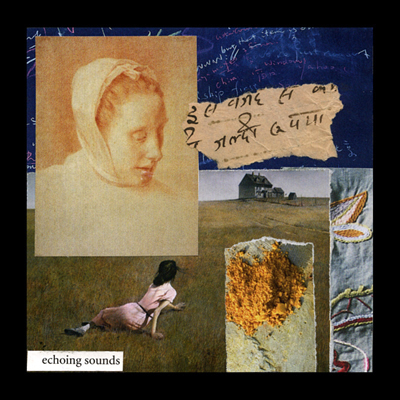 A page from my collage zine "l'invisible" was inspired by Carol Shield’s novel "Swann: A Mystery" about Mary Swann an unknown poet. Recently I ran across Alyson Stanfield’s Art Biz Coach Blog which listed some great summer reading featuring fiction novels with artists as their main characters. It was such a great idea that it had me wondering what books I’d include on my list. The stuff in my favourite novels is always swimming around in my head while I’m making art, that’s why I highly recommend incorporating reading fiction into your art practice – it’s a never-ending source of inspiration for art and life. In fact, the collage pictured above was inspired from a book on my summer 2013 reading list which follows…
The Time Traveller’s Wife (Audrey Niffenegger)
Not as sci-fi as the title suggests but more of a reality-based novel. I know what you’re thinking – how can time travel be based in reality? Well, if it was a reality how would a wife cope if she was married to a husband who time travelled? This intriguing thought propels Niffenegger’s story! In this brick of a novel (I prayed would never end!), Clare, a paper sculptor, meets her husband to-be, Henry DeTamble, when she’s just six years old and he’s a middle-aged man! It’s a romantic, bittersweet adventure full of emotional complications. I highly recommend it. I hear the movie version is very good, too.
Map of Glass (Jane Urquhart)
During spring thaw, while documenting a series of decaying fences, photographer Jerome McNaughton finds the body of Andrew Woodman encased in a block of ice. He strikes up a friendship with, Sylvia Bradley, Woodman’s mistress and together the histories of these two unlikely friends unfold as they investigate the dead man’s notebooks. So sensitively written by Uruquart… if you want to get lost in the wilderness and learn more about the histories of settlers here in Canada, this is a great one to read.
Effigy (Alissa York)
Dorrie, an admirable artist in her own right, grants dead creatures eternal life through her role as a taxidermist. She’s so gifted that at age fourteen she becomes the youngest bride of a Mormon, Erastus Hammer, a polygamous horse rancher and renowned hunter. Elder wives, wolves, nightmares of crows add to the tension of the novel including a love interest – a dark thriller!
The Mermaid Chair (Sue Monk Kidd)
Legend has it that a beautiful mermaid once lived on Egret Island where our heroine, Jessie Sullivan, now a married, middle-aged artist painter grew up. Returning to care for her ailing, estranged mother, she begins an affair with a would-be monk about to take his religious vows. More than torrid romance, this novel reveals Jessie’s coming to terms with her marriage; her taking a stand for her independence and facing a long-buried family secret. Actress Kim Basinger starred in a wonderful film adaptation of the novel – which is such a tear jerker. In the movie, I love the way the fashion and hair production team made gorgeous Basinger look like a mermaid… you’ll want to get out your old crimping iron after you see this one!
Duma Key (Stephen King)
I’ve been a fan of King’s novels ever since I was a teenager. In this tale, Edgar Freemantle, a man on the verge of divorcing his wife turns to drawing and painting while recovering from a terrible accident in which he loses his right arm. Gaining a new (haunted) limb and opting for a change of scenery, he moves from Minnesota to Florida’s Duma Key, an enchanted island with a dubious past. Here his skill for painting improves in leaps and bounds until he becomes a veritable Daliesque painter clamoured for by the local contemporary art establishment – wouldn’t we all love that! King captures the bedraggled human condition so perfectly. I love the way he builds close relationships between his characters. He has a wicked sense of humour, too. I wish they would turn this story into a film!
Pillars of the Earth (Ken Follett)
Artists abound in this historical epic set in the Gothic period. There’s Tom Builder an incredible architect who designs and erects cathedrals and young Jack, a handsome skilled stone carver with a mysterious past. One of the characters in this novel, Lady Aliena, a noble woman unfairly stripped of her title who becomes a thriving wool merchant, inspired my foray into the world of business! There are so many characters in this novel you’ll absolutely love and love to hate! If you appreciate history and architecture, Follett exquisitely crafts his tale in exciting detail which reveals the social, political and economic context surrounding the creation of these magnificent edifices which are literary a little piece of heaven here on earth! A recent television mini-series captured the spirit of this novel brilliantly!
Swann: A Mystery (Carol Shields)
Mary Swann, the wife of a poverty-stricken farmer, is found violently murdered by her husband. This lonely, uneducated poet’s work gathers a great following many years after her death. Working from a bag of poetry scraps left behind by Swann, feminist academic Sarah Maloney attempts to piece together the poet’s life for an upcoming symposium. We learn Swann’s story through a number of characters who shape her story to suit their own purposes. Can academics, historians and even those close to an artist truly know the intimate details of an artist’s life or what made them tick? This novel skilfully explores that question. It’s also the novel that played a role in inspiring a page from my latest collage zine pictured (above)… I couldn’t help but wonder if the woman in Andrew Wyeth’s painting “Christina’s World” (1948) might be Mary Swann herself – just moments before her untimely demise…
And there you have it! There are some links to movie and television trailers below as well as a far-out taxidermy blog which features the work of contemporary artists using the medium to create some hair-raising pieces! If you have any art-related fiction recommendations, I’d love to hear them.
Other Related Links:
The Time Traveller’ Wife Movie Trailer
The Mermaid Chair Movie Trailer
Pillars of the Earth TV Series Trailer
Ravishing Beasts: Taxidermy (blog)
Collage Your World 2012 Zine
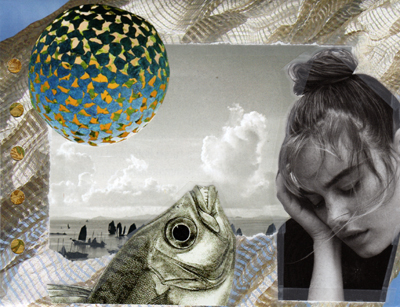 My sea-themed collaged envelope (front) This spring Collage Your World member Jeanne-Sylvie Bellet (France) sent me a beautiful mixed media piece in exchange for a copy of my collage zine. When she mailed it to me, I noticed that it was enclosed in an unusually colourful envelope. Upon further inspection and enquiry, I discovered that it was a handmade envelope! I was so impressed with it that I asked her if she would forward the template to me so I could make one of my own! Since then I’ve been enjoying making my own envelopes and am excited by the collaging challenges* it presents. You can send your envelope through the mail or hand deliver it to a special friend – whichever the case, they’ll be delighted by your efforts!
While surfing the internet, I discovered many envelope templates I could download. I also found a store called The Papery that sells plastic envelope templates here in Ottawa. Despite finding these, I still feel that Jeanne-Sylvie’s is the easiest one to make! So I’m going to pass it along to you…
Six Steps to Making Your Collaged Envelope…
Supplies:
Steel-edge ruler
Bone folder (optional)
Scissors and exacto knife
Clear packing tape or matte scotch tape and thin double-sided tape
Collage papers and magazine bits
Optional: stickers, decorative tape, rubber stamps, Stazon ink
Note: Also see my diagram (below) and my samples to help you.
1 With your exacto knife, cut out a whole page from a magazine. Choose a page that might look interesting folded. Ones that have patterns and textures on them work well; ones that have people in them are cool, too. If you intend to mail your envelope, I suggest choosing a page from a magazine with thickish glossy pages. If you’re not mailing your envelope, use a sturdy magazine paper.
2 Place your page vertically and fold the left and right edges of your sheet inwards… perhaps a quarter of an inch or more. How much you fold your edges depends on the width of the letter or card you want to insert; so test it to see if it fits before you finish your envelope! To get a nice folded edge, fold over with a steel-edge ruler or score the page with a bone folder and then fold. Rub over the folds with a bone folder or your finger nail to flatten the fold.
If your page is not wide enough to contain your letter/card, you can add part of another page onto it to increase the width. Stick the two pages together (back and front) with packing or scotch tape.
3 Fold the bottom of your sheet upwards to create a pocket big enough to hold your letter/card. Remember to leave enough room at the top to fold a flap downward to close your envelope.
4 Unfold your envelope (except the left and right edges), turn it over and decorate the other side. This will be the outside of your envelope. You can embellish it with: magazine fragments, decorative papers, stickers, decorative tape… if you like, rubber stamp it with Stazon ink! (Most other inks will not dry on magazine paper.)
While decorating, keep in mind the areas where you’ll be placing your return and mailing addresses as well as your postage stamps. You can hand write your addresses in permanent marker (ie. Micron pen, Sharpie). I like to print out addresses on labels with my label maker because they stand out well for the postal service. At this stage you can be as creative as you like by strategically composing your design so it’s visually compelling. My sample (above) turned into an aquatic theme because the base page that formed my envelope had an image of fish net on it. This also inspired my sea-themed scanned note paper (below).
For those of you who feel challenged enough just putting the envelope together and don’t want to collage on it, no worries! If you’ve picked an interesting page … it will look simple and super, too. You need only stick on your address labels and stamps when you’re done … so skip the next step and proceed to 6.
5 When you’re ready to stick the images on your envelope, if you’re using glossy paper, I suggest you use packing tape or matte scotch tape to adhere the images. You can use double-sided tape where needed as well. I don’t recommend using glue stick because it doesn’t adhere well to glossy surfaces. These thicker tapes will make your envelope more durable and a bit waterproof.
6 When you’re ready to refold and finish off your envelope, adhere the left and right edges that form your envelope pocket together with double-sided tape. Make sure the tape is the exact size of your seam and not wider or you might lose some width if it is and your letter/card (depending on the size) might not fit by a fraction of an inch! So trim your double-sided tape if you need to. Once you’ve inserted your letter/card, you can seal the envelope with decorative tape. If you’re not sure if your tape is strong enough to withstand the mail service, reinforce it with some scotch tape in places.
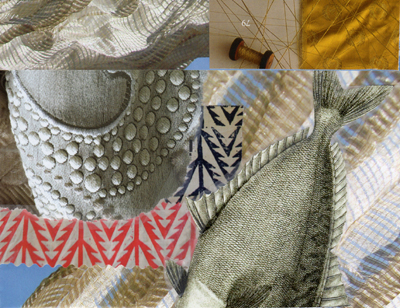 My sea-themed collaged envelope (back) 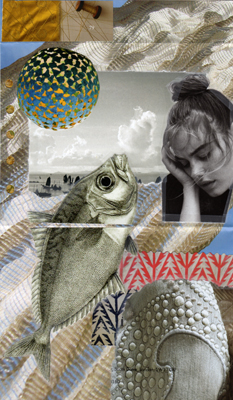 My sea-themed collaged envelope (whole front, unfolded except edges) 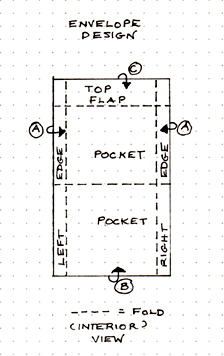 Diagram of envelope design... 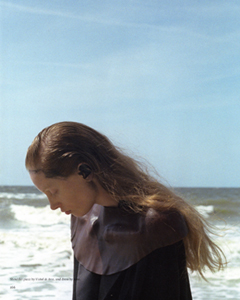 My letterhead is a magazine page I scanned, re-sized to fit in my envelope and printed out. And there you have it! Or as Jeanne-Sylvie might say in French: Voilà! – your own custom-made collage envelope! Bonne chance (good luck) making yours! If you do, I’d love to know how it goes. If you need more details about the how-to’s, I’m just an email away! Un grand merci pour cette merveilleuse idée, Jeanne-Sylvie!
Note: I must add that while two of Jeanne-Sylvie’s envelopes made it to me from Europe, for some reason, the one I sent her was returned to me!!! I’m in the midst of finding out why and will update you soon!
Other Related Links:
My New Collage Stationary!
Collage Your World Zine: L’invisible/The Invisible
 Michelle Casey, “In Memoriam: Elizabeth Wortman”, 6 x 8.5 inches, Collage/Mixed Media Journal Page, January 2010. Women like my neighbour, “Bessie” Wortman, made me realize the importance of following my dreams. See below for text of this journal page. Lately I’ve been reminiscing about the day I came up with the name for my business: Collage Your World (CYW) and the impetus behind it. Besides echoing the old paint store, Colour Your World, CYW invites ordinary folks to learn to express themselves through collage. For me, imparting this knowledge is as important as my role as artist. As viewers/interactors of my work and potential students, it’s my wish that you will choose to use it to empower yourself and actively engage with art in your life. Here’s the story that motivated the birth of my art biz…
In my third year of studying visual art at university, our department found out that its budget was about to be slashed. This meant that some amazing teachers and courses would be cut from our program. It seemed whenever the university needed to cut from the Arts, our department suffered the most casualties because visual art was not deemed as vital to society as: physics, engineering, computers, mathematics, or even ironically, medicine. Until that moment, I’d never been part of an organized student protest before. I tended to shy away from these things preferring to disappear into the background. This time, because a matter close to my heart was at stake, I decided to play an active role in our student group helping to design a poster and agreeing to participate in a sombre funeral-like march to the university’s main building to protest the unfair economic blow being dealt to us. Putting my pride aside, I also agreed to collect signatures from the public asking them to join us in solidarity to protect our budget. I was disheartened to find a surprising number of people balking at my request… they made me feel as though I was a lunatic to think that art even mattered to their lives. One such incident brought me to tears. In the end our efforts were in vain; the cuts were made. The act of taking a stand for something for once in my life however, strengthened my fighting spirit. I was more determined than ever to one find a way to combat the ethos that felt art didn’t matter … totally ignoring the fact that, if given half a chance, the visual arts could play a vital role in improving and enlightening our lives.
As I began to reflect upon why art didn’t matter to the average person, I realized that it was because budgets such as visual art were being cut left, right and centre over the decades in elementary and secondary schools here in Canada. Only the children of the privileged few who attended specialized schools that valued the Arts had the opportunity to appreciate it and gain valuable knowledge to develop their expressive skills. A vast majority of students hadn’t learned to “read”, research and appreciate visual art in the way I had at university. You know, nothing beats being in a room full of people wielding their creative energy! Their excitement is contagious and is something to behold and be a part of. While I was privy to these experiences, the average person, unschooled in visual arts, was busy surviving life; they didn’t have time to learn the benefits of integrating art into their lives. For many, art will only ever be that traditional framed print of a water colour or oil painting that perfectly matches their living room sofa. The business of the selling of art to consumers is happily taken up by big box home furnishing stores. Through them the public will only ever get to know a handful of old masters or modern artists like: da Vinci, van Gogh, Picasso, Matisse or Dali. As many don’t have artist friends, they will rarely come into contact with real art or the artists that produce it. For these folks art is meant to adorn empty spaces on walls and is not necessarily understood for its life-enriching purposes. From this point on I knew my mission would be to alter this perception even if only in some small way in my own community and, with the help of social media, perhaps other little pockets of the world – a lofty vision! I started by making and teaching art that was accessible to many and art that played a crucial role in transforming my life. I felt collaging journaling and vision boarding would be easily attainable art forms and be beneficial to a vast majority of people. Collage Your World has been 15 years in the making. It’s been a slow, painful labour of love for me to arrive here. And, I’m so grateful I’m still here and that so many of you care enough to listen, comment and share your art and reflections with me.
For me, art has always been about healing. In a home where money was tight, dreams of going to Disney World and summer vacations to far away places were not a reality. Instead, my flights of fancy were journeys to worlds created with papers, glue, scissors, and crayons or markers. My dysfunctional family life didn’t include professional counselling. Instead, it involved using the tools of art to invent places I could retreat to in times of trouble. In practicing my art I also derived its healing and meditative benefits without even realizing what it was really doing for me. Art has played such a crucial support role in my life therefore I’ve never solely viewed it as an activity to make objects to beautify my walls… it’s so much more. Some come to my classes wanting to create beautiful pieces, but they don’t realize that the true beauty of art is not necessarily in the outcome of the look of the piece but the energy and courage expended to express oneself in concrete form. The role of artist as a means to express one’s self is open to everyone. Here at Collage Your World I encourage you to live, cut and paste with me… no matter what challenges we face in life, together through art and collage, we’ll find ways to transcend them!
Journal Page Text (top of page): “I met Bessie Wortman when I was 12 and she was 80-something. She taught me to appreciate every second of life. She introduced me to Harlequin romances. She taught me how to make fried green tomatoes. Most importantly she told me to follow my dreams no matter what people said. Thanks Bess, I miss you.”
PLEASE NOTE: I’ll be off for the next couple of weeks attending to pressing personal matters. Will return June 16, 2013 with tips for creating collage envelopes! Also stay tuned for my June Newsletter and Zine Portfolio page coming soon…
Other Related Links:
Birthdays, Business & Collage
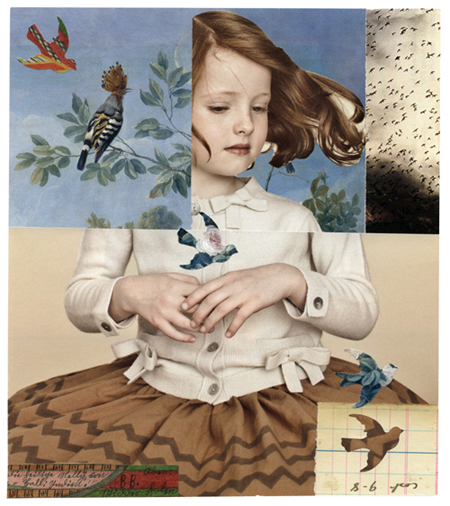 Michelle Casey, Untitled Collage, 4 x 4 inches (approx.), April 2013, Inspired by a quote from Fréya: “Inside us all patiently waiting sits a tiny little adventurous bird." There’s No Right or Wrong Way to Collage a Quote…
I thought I’d end my writing series (for now) with another fun tip for integrating words into your collage and mixed media pieces. We’re not all great writers and thinkers so it’s a good thing there are plenty of wonderful quotes out there that we can use as jumping off points for our work*. When I first started incorporating quotations into my collages, I worried about how I would illustrate them and then I realized there was no right or wrong way to do this. The trick was to first look inside myself to see what feelings and images emerged when I thought of the quote; then to collect that type of imagery, and finally to narrow those down to only the few that truly captured its essence. Remember too, you don’t need to illustrate a quote; you can choose to tackle it in an abstract manner by building shapes, colours and textures around it. Instead of using pictures of people, places or things, here you might try to capture the feeling of the quote through colour, texture or simply random patterns and shapes that appeal to you.
My Grandmother’s Book of Quotations…
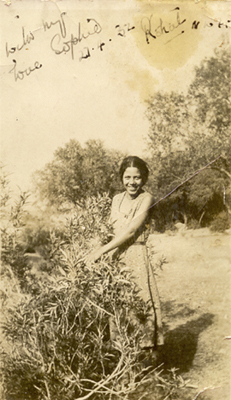 My maternal grandmother Sophie Guider in Kohat (Pakistan), 1932. I never thought I’d be one of those people who’d be attracted to quotes but I am and it all began in my late teens when I received a gift from my maternal grandmother Sophie. Upon her passing, she left me a small book of quotations by esteemed Classical Greek authors: Pliny, Plato, Plutarch, Aristotle … a whole slew of men with strange names I couldn’t pronounce who had something to say about life and the proper way to conduct one’s self through it. Printed in the late 1800’s, the book was well-worn; it was so tiny it fit in the palm of my hand. Its dilapidated ivory cover was cracked so much so that the stuffing was coming out of it; its creamy pages were stained with age. When it was brand-spanking new young Sophie Guider was a Eurasian governess travelling between the Indian subcontinent and Europe … sometimes to England and even to France with her young charges and their families. She also travelled throughout India seeing to the education of children from Indian royal families who gifted her with precious jewels! Sometimes I envy her early life although I know it must have been very difficult for her having lost her parents at age sixteen. This book must have been very precious to her because with it she could ensure she duly impressed her employers through her thoughts and good manners. As a young single woman of mixed race origin in the 1920’s being perceived as an intelligent and cultured woman would have been crucial to her personal, social and economic survival in India. Sometimes, I imagine her on a train travelling through India or perhaps on a ship sailing past the White Cliffs of Dover leafing through its pages… wondering what gem of thought to use next…
Thousands of Quotes in the Palm of our Hands…
Today with social media tools like Pinterest we can collect thousands of our favourite quotes and have them in the palm of our hands as well. I wonder what Sophie would think of that! She always had something sassy to say about the modern world. One day I’d love to do a series of collages of my favourite quotations. I’ve just begun collecting them from my friends on Facebook these last few months as well as making a Quotes board on Pinterest. Below is a list of eleven of my favourite ones. A quote by Fréya (#5) inspired the collage above. When I thought of it, it reminded me of blue skies, birds, freedom, music and my childhood along with a sense of wonder of being tuned to what’s within. Instead of writing or adding text to the collage itself, I decided to handwrite the quote below the image (not pictured here) which I mounted on paper. I did this because I wanted to leave the piece open to other interpretations.
What’s your favourite quote? Have you tried to build an image around it? I’d be curious to know… I do hope someone will share a piece of theirs with me or at least give this tip a try and let me know how it goes!
* Note: Quotes don’t have to be from notable celebrities; don’t forget those everyday folk you’ve encountered in your life who’ve said some pretty wise and inspiring things to help you along your life’s journey! Keep a little note book to write down these gems of thoughts as you hear them.
11 Favourite Quotes to Inspire Your Collaging:
1 “You are of infinite worth.” (Thanks to my friend Faye Estrella for sharing.)
2 “A certain darkness is needed to see the stars.” (Unknown)
3 “Every artist dips his brush in his own soul, and paints his own nature into his pictures.” (Henry Ward Beecher)
4 “Give the ones you love wings to fly, roots to come back, and reasons to stay.” (Thanks to my friend Stu Hyderman for sharing.)
5 “Inside us all patiently waiting sits a tiny little adventurous bird.” (attritubted to Fréya?)
6 “Lend me your eyes I can change what you see.” (Mumford & Sons)
7 “I wish I could show you when you are lonely or in the darkness the astonishing light of your own being.” (Hafiz)
8 “When I’m dancing I feel like a breath in the sky.” (Young dancer in Freya Björg Olafson video.)
9 “Hope is the thing with feathers that perches in the soul and sings the tunes without the words and never stops at all.” (Emily Dickinson)
10 “Be still and know.” (Unknown)
11. “Be the change that you wish to see in the world.” (Mahatma Gandhi)
PS: Be sure to check out My Pinterest Quotes Board for more ideas! If you’ve got a quotes board I can re-pin from, do let me know.
Other Related Links:
Changing the World, One Collage at a Time (“Be the change you want to see in the world.”)
My Portfolio November 2009 Journal Page (“Make the most of every day, life is short”.)
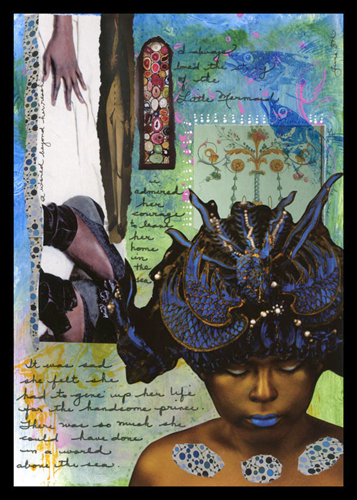 Michelle Casey, "The Little Mermaid", Collage/Mixed Media Journal Page, 8.5 x 6 inches, 2010. See lower down for written text. Since time immemorial, story tellers have been taking old stories and making them new again. Walt Disney after all was not the first man to relay the tale of Cinderella – its origins are centuries old and it has been re-crafted by many cultures around the world. You can use this same exciting tactic in collaging your own art pieces. Instead of repeating the same old, try giving a pre-existing story your unique spin. Find something in it that’s based on your struggles as a human being. When you introduce new interpretations of stories, you can expand a viewer’s imagination and perspective of the world. Through this you can perhaps create that “Ah ha!” moment for yourself and for others as they discover new exciting elements and insights from your tale. To do this you must continually ask yourself: how can I make this piece my own? So today I thought I’d share a few of my personal and emotional strategies for creating such a journal page…
Like Me She was a Creature from another World…
Hans Christian Andersen’s fairytale “The Little Mermaid” inspired a journal page of mine in 2010. Part of a series to be installed at the Ottawa Public Library, the piece would be displayed near the children’s book section, so I wanted some works to reflect stories from my childhood and this one sprang to mind. As a dark, South Asian immigrant girl growing up in 1970’s Canada, Anderson’s tale captivated me. I was particularly fond of the 1975 Reader’s Digest animated version compassionately narrated by actor Richard Chamberlain. In it a (nameless) little mermaid is portrayed as a young white girl with flowing auburn hair. My affinity to her arose because, like me, she was from a different world and desired to part of another – the world of humans who lived above hers on land; while I longed to be part of white English and French Canadian society. The mermaid sought this because she had fallen in love with a handsome Prince from that world whose life she saved in a shipwreck (unbeknownst to him). Trading her precious tail and melodious voice to a sorceress in exchange for a chance to win the Prince’s love, she risked losing her life if she failed the task. Without a voice to convince him, her mission seemed doomed from the start. Many know her tragic fate of losing the Prince’s love to another and her refusal to kill him to break the spell so she could return to the sea. Tears rolled down my face as she selflessly chose death. As her soul drifted up to heaven, I wondered if my own love story would be as tragic. I felt such empathy for one who had risked everything for love only to have to relinquish her dreams. With this tale my twisted fascination for unrequited love grew – I saw great beauty in its sadness. The story’s ending, as heartbreaking as it was, invited many interesting reflections, one of which I include in the written portion of my journal page (see next paragraph). Decades later, I would hardly advise any young woman to give up her life for a man, not even a prince!
Giving My Spin to Anderson’s Tale…
Flash forward to my 2010 journal page… upon discovering photographer Kimiko Yoshida’s mysterious “Phoenix Bride Self Portrait” (2005) in a photography magazine, I saw in it the potential to become my little mermaid. I loved the brown/black/blue hue of the girl in Yoshida’s portrait. Her luminous skin and blue cerulean lips were so other-worldly; I felt they evoked my idea of a mermaid perfectly. I loved too that I could transform the ethnicity of the mermaid to match something that was akin to my Asian background or even an African one for that matter. I knew, in this day and age, that the library was a multi-cultural space and I wanted children of colour to also be able to envision themselves in my version of the story. To reinforce this feel I added the legs and arms of a young Black woman and also chose the slim figure of an aristocratic white European man to stand in for her Prince – implying an inter-racial romance (like my own). In doing these things I gave my own personal spin to Andersen’s fairy tale; making it mine… one as different as Andersen’s and Disney’s that would follow. In the text portion, I suggested a contemporary reflection about women and romance in Andersen’s tale. This was inspired by my studies in my art and feminism and contemporary art classes in which we discussed women’s roles in stories and society over the ages. It’s so important for me to bring to light stories of old that I’ve loved and alter them in my own way. It feels so empowering to re-create something new out of an old tale and to give voice to my own experiences and knowledge as a woman. These are strategies I offer you to take up…
The following is the text from the journal page (above) as read from top to bottom:
I always
loved the story
of the
Little Mermaid
I admired her
courage to
leave her home
under the sea
It was sad
she felt she
had to give her life
for the prince.
There was so
much she could have
done in the
world above
the sea
She could have been me…
A world beyond her reach…
Image Reference: Photo of girl by Kimiko Yoshida, “Phoenix Bride Self-Portrait” 2005, Color magazine #8 July 2010.
Making a Story Your Own By…
Ask yourself what stories, themes and ideas attract you the most and how could you transform facets of them in your work? In my “Little Mermaid” page my ethnic background, a favourite fairytale, feminist and contemporary art knowledge helped me to re-fashion the story into my own version. In other words what knowledge and experience do you have inside that “colours” the way you see things in life? Use these to re-invent your own unique story.
Have you altered an old story and made it your own? If so, I’d love to hear from you. If this concept is new to you, consider taking a few moments to think of a favourite story, then jot down two or three things you could try this week to spice it up. Happy collaging!
Other Related Links:
Ceremonies of Disappearance: Kimiko Yoshida’s Critique of Identity
 Michelle Casey, "All that Remains", Collage/Mixed Media Journal Page, 8.5 x 6 inches. See lower section of blog page for written text. Practicing what I preach, I thought it might be cool to share a minimally edited excerpt of one of my creative writing journal exercises of 2005 with you and reveal how some of its iconography and memories manifested itself in a visual journal page I created in 2010. That April day the writing prompt dictated I write about hands… any hands, really…
April 8, 2005, My Father’s Hands
(Written in 20 minutes while sitting at my desk listening to a religious-inspired internet radio station.)
They were medium sized. But they always seemed a lot bigger with fingers thicker than mine. Hands that had the well worn look of time: deep brown and hairy on the outside and pale pinky beige on the palms. Well manicured nails; always kept short. Sometimes I’d see him biting them, but not often. I remember he had a thick gold custom-made ring with his initials VFS: Vincent Florian Serrao on his wedding ring finger. It was a handsome ring; elegantly crafted. I think it had been specially designed for him because I’ve never seen anything like it before. It had a kind of Art Deco feel to it. The “V”, the “F” and the “S” were intertwined and they rippled out of the centre of a rounded square face. It was beautiful and I was mesmerized by it. Later, when my mother would need some extra gold, she would melt that ring down. She replaced it with a cheaper watered down version which looked like so many other monogrammed rings you find nowadays: a dark, ebony-like squarish centre with his initials carved into it and inlaid in gold; not as striking as its first incarnation. I was saddened mom had done that. That was when dad had cancer and mom was visiting relatives in England; he was too exhausted to complain about what she’d done. Those were the days when they had fallen out of love. Wish I’d known what she was going to do with it. I’d have put a stop to it. After he died my mother gave that precious ring to one of my sisters. Why, I don’t know. Although my sister was close to my father when she was little, when he lay sick and dying she was too afraid to approach him; they grew apart. The day he died, my mother never even called her to tell her he was at death’s door. The last time I saw dad I was holding his hand for the entire afternoon and evening as he lay dying. I didn’t know if he could hear me or see me, all I knew was that I wanted to communicate my closeness to him by holding his hand. His hands were cold; I tried to warm them with my own. He didn’t hold on tightly. He drifted off often. Those hands… I was informed later, had knitted clothes for me as a baby. They even sewed clothes for me. They had patted me to sleep on the nights when I was most afraid that the devil and the darkness would spirit me away. For seasons: spring and summer flowers blossomed delighting in their touch. With them, elegant functional furniture was conceived and crafted for our home for many years. Those hands taught me how to knit with precision. They showed me how to make an expert chickpea salad – chop the onions fine, little dash of oil, vinegar and lemon juice, salt and pepper to taste and a pinch chili powder to give it some zip. Never forgot that recipe. Although those hands threatened to beat me when I was wicked, they never had the heart to carry it through. The one thing I really wish I’d seen those hands do though was play music. Those hands that once: tickled the ivories; caressed the strings of the violin; exhaled the notes of a clarinet and played drums like his idol Gene Krupa. I wish I was witness to my father’s days playing with his band in Rawalpindi. I wish I could hear the sound of the music that was produced by those sacred, passionate and loving hands…
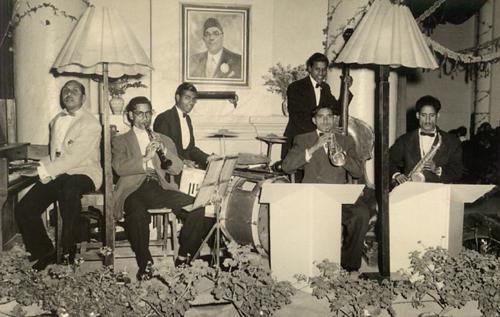 A photo of Dad and his band. He's the drummer (centre). This photo was probably taken in the late 1950's or early 1960s at the Rawalpindi Military Club in Pakistan. Text for Journal Page (see top of page):
“Holding your hand as you lie in bed; the unbearable wait for morphine; I watch as two nurses ignore your pain. Your frail body holding on to life with all its strength hoping to beat the cancer that consumes all our lives.”
(Please note that this piece was created in Kelly’s Kilmer’s “A Life by Hand” on-line course which I highly recommend.)
So there you have it… perhaps now you know a bit why my dad’s spirit haunts me so. I’ve done many works in different mediums based on his memory: collage, mixed media, digital collage and multi-media. I’ve gathered a thousand pages of oral history about my father’s life from his friends and relatives. My fascination with him never ends… my art helps me keep his memory alive…
Other Related Links:
Life through the Arts: Surviving the Impossible Dream
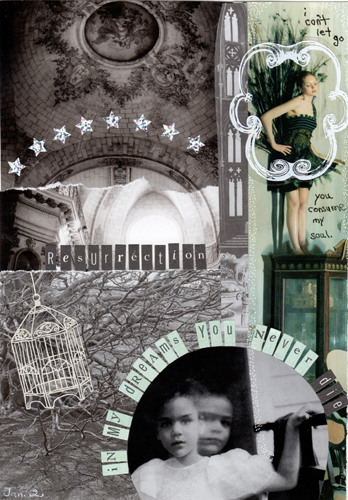 Michelle Casey, "Resurrection", Collage/Mixed Media Journal Page, 8.5 x 6 inches, January 2010. Text in handwriting: "I can't let go... you consume my soul." So, some of you more timid souls might have gotten out your pens and markers and went about writing on your collages as I encouraged last week. If so, I applaud you. Perhaps, however, you’re still feeling frustrated. Maybe the words aren’t flowing out as smoothly as you’d like them to. In order to be successful at integrating words into your visuals, you must draw from all you are and all you can imagine within yourself. I know this will sound daunting to some of you; especially those of you who got Cs and Bs in English grammar and literature (like me) and who are probably saying “Hey, I ain’t no poet laureate or Pulitzer Prize-winning writer! Hell, I ain’t even no Maya Angelou!” Even so, I think you really ought to consider taking up writing in your art practice; it’s a strategy that can really help you draw from the depths of your soul. It’s also one of the most exciting elements you can add to spice up your art making. So many artists I admire, such as Frida Kahlo, have recorded their life’s reflections in their journals or diaries; these reflections are often echoed in their most powerful pieces. Writing allows you to get to know yourself deeply. Drawing from your writing, you’ll be able to secure the imagery and words that are most meaningful to you.
Writing Opened Up New Avenues for Me to Explore…
I don’t know about you, but by the time I finished high school the love of writing fiction and poetry was zapped right out of me! Determining my self worth as a writer by my English marks didn’t encourage this lover of stories to want to write her own. Even still, there was a tiny burning ember within me that still longed to write and, one day in a desperate attempt to find a creative writing workshop, I serendipitously bumped into a stranger who recommended reading Julia Cameron’s: “The Artist’s Way“. She said it fostered the habit of writing on a regular basis, which was crucial to creative writing. As Cameron advised, I began writing for 10-15 minutes a day (or almost) in my Morning Pages journal. I did this for a few years and it was good therapy for me as I was depressed about my life and art career at that time. While I didn’t feel I was doing any creative writing, I found my journal pages revealed a concrete portrait of myself through words. I realized, even with my troubled life, I had many fascinating stories, ideas and life altering experiences I wanted to share with others. Furthermore, writing the same complaints about my life down over and over encouraged me to acknowledge and change my negative life patterns. Keeping a written journal was such a godsend for me. Encouraged by this, I moved on to Judy Reeves’ “A Writer’s Book of Days“. For seven months I kept a creative writing journal and followed her weekly writing prompts. Soon my journals were filled with stories based on my life events (ordinary & extraordinary); favourite fiction and macabre news events I was drawn to. This was a scary and exhilarating experience for me. Many times I couldn’t believe this writing was coming from me! I felt proud of being able to invent things on the spot – I didn’t know I had it in me. Writing opened up new avenues for me to explore! For the first time I began relying on intuition* to create something expressive rather than planning things out as I often did in my art.
*Note: Writing prompts are supposed to be spontaneously written – so that means no planning ahead of time!
Writing is a Soul Sister to Visual Art…
Feeling nostalgic, I recently dug up my creative writing stories last month. As I reviewed them, I noticed much of their content and imagery was also reflected in my visual journals years later. I noted how my creative writing theme obsessions (recurring dreams and nightmares, family traumas, ill-fated relationships) were transferred to my visual journal pages and I realized how synonymous the two were for me and how well they complemented each other. I realized too, I could go back to my creative writing journals and draw many more stories for my collages from them – a real bonus! As a result, I could never be a person that believes that words have no place in their art practice. For me, writing is such a soul sister to visual art – the two feed each other beautifully and unleash so much more creative energy to art making.
Revealing Your Authentic Self…
Today my next recommendation to you is to consider getting into the habit of writing on a regular basis… even if it’s just ten minutes a day a few times a week. Write the things that immediately come to mind on any given subject that attracts you. You can follow Reeves’ or Cameron’s books as guides if you like and see what happens (see Goldberg and Morris below as well). What emerges will inevitably be the things that matter to you… the life-learning experiences that have shaped you and your thoughts. I promise, once you embark on this tremendous journey of getting to know yourself, it’ll help inform the type of words and imagery to begin to play with and experiment with in your collage pieces or journal pages. I truly believe it’s in having the guts to explore the murky depths of yourself more fully that you can begin to develop an authentic voice and style through your art that is uniquely YOU! Now I know some of you will also be saying “Hey, I don’t have several years to practice my writing – I want to do everything perfectly NOW!!!” To this I respond, all good things come in time… the clock is ticking, what are you waiting for?! When you’ve worked enough, you’ll know because the most poignant words will often (but not always) flow from you with the greatest ease – at that time you might think of it as magic, but in reality they’ll appear because of the effort you’ve put into your writing practice.
To conclude, let me share a piece with you. The journal page (top) was informed by a dominant theme: recurring nightmares I had over the years about my late father. When I wrote these texts I felt the words were coming from the dual view point (of myself) as a young girl and as a mature woman so I used writing styles that would reflect both written “voices”. My printing on the right side of the page was a tactic imparted to me by art therapist Dr. Lucia Capacchione who suggested writing with your non-dominant hand (in my case my left one) to bring out what your “rational” (my right hand) might not say. I liked trying this out because it gave the printing a very un-certain, child-like emotional quality that’s the opposite of the phrase in stickers which appears so sure, so exact. Here, for me it’s the varying and contrasting of writing styles that gives the page a further expressive impact and edge. Does keeping a written journal inform your art practice? I’d be curious to know…
Please Note: I will be away on training next weekend… back on May 5, 2013!
Other Related Links:
Collage Tip #8: Collaging a Dream Journal
Natalie Goldberg’s “Writing Down the Bones”
Cynthia Morris’s Original Impulse Blog
Dr. Lucia Capacchione
Recently I was asked to give some further advice on adding text to collage. The person inquiring feared that adding words to their beautiful pieces might potentially ruin them if they did the wrong thing. Having been there myself, I could really relate to their apprehension. As a result, I’ve decided, for the next few blog entries, to look back on my journey as a collagist attempting to integrate my personal thoughts and feelings into my work through text and give you some tips.
Why Complicate Images with Words?
If you firmly believe in the power of images, it’s a bit of a conundrum to contemplate adding text/words to your art. Some believe they have no place in visual art and that they belong to the realm of literature. After all, when used effectively, images are as powerful as words. You must have heard the saying “a picture is worth a thousand words” so why complicate things especially if an image clearly reveals its message and adding a word or more might end up being repetitive and unnecessary. In some cases, it may even deter viewers from exploring or “reading” the visual worlds you’ve created. So why spoil a perfectly good collage by adding writing to it? Well, for me as with the artists I admire, I’ve done so because I love taking chances and pushing the boundaries of my art further. Ever since I went to art school and saw people like Barbara Kruger, Carl Beam and Duane Michaels using text in their artwork… some personal, some derived from media sources, I knew it would be one of the challenges I wanted to take on in my art too.
Transforming “Mistakes” into “Opportunities”…
At first I was afraid of messing up my pristine collages with words. There were so many things to consider when adding them: were they really necessary? What they would say? What style and colour they would be? Where I would place them? I eventually got over this fear because what was important to me was learning to create work that was emotionally powerful and compelling and I knew in this endeavour that my art would be suffering some casualties in the process of experimenting to uncover the answers to these questions. The importance of taking chances was impressed upon me in a series of workshops I’d taken given by extreme visual journalist: Juliana Coles. In her class, Coles dared us to create “ugly” journal pages in the name of innovation and experimentation. In order to do this, we knew we could no longer view our pages as potential masterpieces. Since then I’ve learned to view every piece I make as an experiment in learning to push my art to its fullest expressive potential. That’s why I always say being a good visual artist is a lot like being a mad scientist! There’ve been plenty of pieces that I’ve buggered up along the way but these have been golden learning opportunities. As much as I’d like to call them “mistakes”, I’ve learned they’re crucial learning guides to improving my collage techniques. Without them, I wouldn’t be the artist I am today. It’s in struggling every step of the way that we learn to grow in our art practice. Most of us are not born art prodigies; instead we must work diligently to become good at what we do. With each unsuccessful piece, I assess my “mistakes” and find ways of setting them straight. In doing this, I learn to be more innovative and creative. Every collage is an experiment in pushing the boundaries of my knowledge of collage. I can’t stress enough how important maintaining this attitude is in developing your own art work… ultimately, it’s the thing that gave me the power to inscribe some soul into my work with pencils, markers and pens! And I encourage you to do the same!
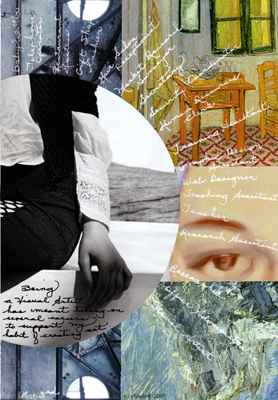 Michelle Casey, Untitled Journal Page, Mixed Media/Collage, 8.5 x 6 inches, March 3 2010 To conclude, I’ll share a sample of a piece I learned much from. This visual journal page (above) was made while taking a course with artist Kelly Kilmer; it lists the many careers I’ve had while maintaining my art practice. I loved the composition, visually and texturally; my friend Diane thought was cool because it reminded her of looking into a keyhole into someone’s private room. When it came to adding text, however, no matter where or how I placed my list, I didn’t like the way it appeared horizontally or vertically on the page. So I was forced to consider other options for displaying it and I decided to add it a circular/radiating fashion around the focal (main) image which I really ended up liking. It made me realize that words don’t always have to be read across or up and down the page… that they could follow the shapes/forms within my collages creating more interest and giving the composition a stronger visual impact. Further, the writing also became a visual element in that it appears like a drawn circle around the focal – so neat! I also learned that my white pen wrote best on surfaces that were semi-gloss or matte (not glossy!) – I had to remember to strategically choose the papers I chose for my writing sections earlier so I could actually write on them! I also had to consider what colour pen to use, as black shows up best on lighter backgrounds and white on dark ones. So much learning from just one journal page!
Texts on Journal Page Above: In circle… “Being a visual artist has meant taking on several careers to support my habit of creating art.”; Radiating text… “baby sitter, telephone operator, restaurant hostess, gift shop cashier, hair salon receptionist, market research surveyor, secretary, security coordinator, human resources clerk, training assistant, graphic design specialist, web designer, teaching assistant, teacher, research assistant, researcher, office administrator, visual artist.
Additional Writing Tips:
The following is a list of permanent pens that write on most surfaces. Special thanks to Kelly Kilmer and Heather Hayley (Heather’s Stamping Haven) for giving me these tips:
– Black Micron pen (they come in a variety of other colours)
– White Signo Uniball pen (they come in red, blue, gold and silver)
– Permanent Sakura coloured pens: Gelly Roll, Soufflé, Metallic or Star pens
– Sharpie permanent markers
BTW writing your text on transparency film and moving it around the page will help you decide where to place your text in your piece without actually writing on it right away – This is something I discovered on my own!
If you have any thoughts or tips regarding adding text to artwork I’d love to hear them.
Other Related Links:
How to Make a Collage Artist Trading Card (See “Finding the Right Text” section)
|
|















